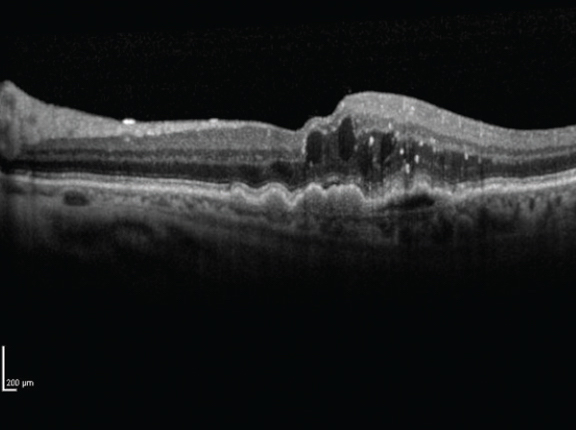 |
| AMD is one of the most common macular conditions that may only be identified during cataract surgery screening if OCT is used. Click image to enlarge. |
Fundus evaluation, even with binocular indirect ophthalmoscopy, may be unable to detect subtle macular changes in the preoperative evaluation for cataract surgery, according to a new study. Researchers aimed to demonstrate the importance of OCT in identifying macular changes in patients over 60 years of age and found that the technology should be considered when evaluating this population, as it identified several macular changes at clinical examination.
Of 364 eyes from 212 patients over 60 years of age that were screened, 300 eyes (180 patients) were included. Eyes with a previous diagnosis or clinical evidence of macular disease, or with media opacity preventing OCT from being performed were excluded. All of the participants underwent OCT and were then divided into two groups: patients with macular changes on OCT and those without.
OCT identified macular changes in 13.3% of eyes, with age-related macular degeneration being found in 4.3%, epiretinal membrane in 4%, intraretinal fluid in 4% and macular hole in 1%.
“OCT proved an effective method for identifying macular diseases not detected at clinical evaluation prior to cataract surgery,” the authors concluded in their paper on the study for Journal of Cataract and Refractive Surgery. “Therefore, the relevance of performing OCT in these cases was confirmed and should be taken into consideration, particularly when evaluating patients over 60 years of age.”
In the group in which macular abnormalities were detected on OCT, 87.5% reported a personal history of at least one of the conditions evaluated, a percentage that is higher than that of 68.1% in the group with no abnormalities on OCT. The finding of a greater prevalence is the same result as a previous study, which found an association between the presence of epiretinal membrane and diabetes even in patients without clinically evident retinopathy.
“As the prevalence of the principal retinal diseases increases in direct proportion to the age of the population evaluated, for the those over 60 years of age the benefit of OCT use could justify the cost,” the authors explained. “Despite the high operational cost of OCT, its expressive effectiveness in the preoperative evaluation of the population over 60 years of age brings greater equilibrium to the cost-benefit relationship by establishing a realistic prognosis and contributing to more realistic expectations of post-surgical outcomes,” they concluded.
Boalento dos Santos B, de Lima Batista Ribeiro Junior, Garcia Perussi N, et al. Optical coherence tomography to identify macular changes not clinically detectable in elderly cataract patients. J Cataract Refract Surg. [Epub ahead of print.] |

